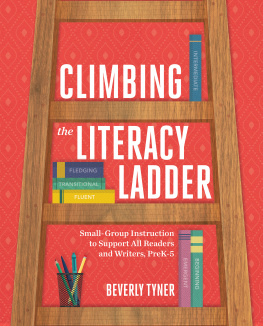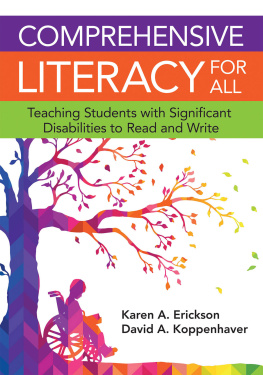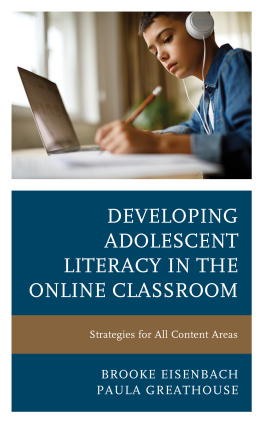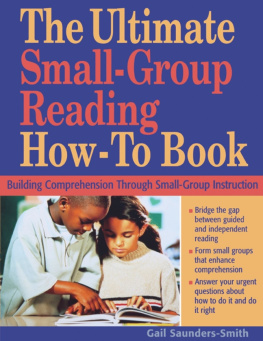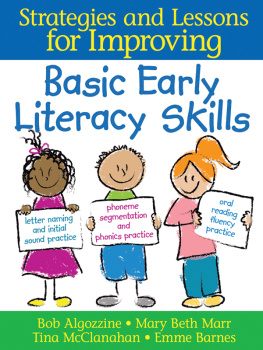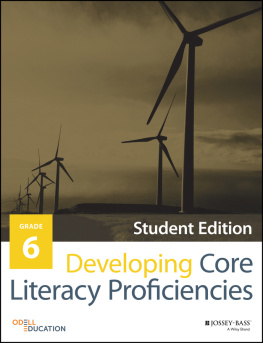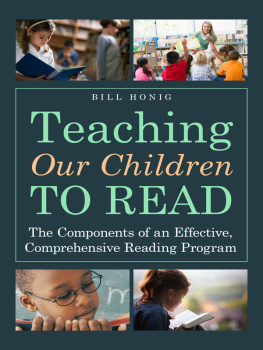Contents
Guide
Pages
Dedication
....................
I am sure you can identify when I say that I had a professional soul matesomeone who shared my teaching philosophy, dogged determinedness, and a burning desire to help both teachers and students strive for excellence. Martha Temple Todd loved teaching and children. She was the lead teacher for the academic intervention team with the Santa Rosa School District in Milton, Florida, when I first met her. As a consultant to the district for eight years, Martha and I developed both a professional and a personal friendship. Martha was truly a teacher's teacher. She began her teaching career as a 5th grade teacher at Rhodes Elementary School. When Martha was faced with breast cancer and chemotherapy, she refused to leave her class to a substitute but instead taught from her rocking chair in the classroom. Martha affected countless teachers and students. Her steadfast faith, booming laughter, and knowledge of how to teach reading were gifts she never stopped sharing. She is greatly missed by all who knew and loved her. In the depths of her illness, Martha left us the following message: Every day may not be good, but there is something good in every day! This is for you, Martha.
Chapter 1
Small-Group Differentiated Reading and Writing
....................
Introduction
After I finished writing this book, I asked myself, "How much of this information is truly necessary to give teachers the tools they need to be effective literacy teachers for all students?" With that guideline in mind, I proceeded to reexamine each chapter and take out all of the "fluff"the material that's nice to know but not necessary for busy teachers to wade through. And here we are.
But more important, here you are, starting another book about literacy instruction. What knowledge do you hope to gain from this book? What are you looking to learn? Let me be frank. If you're looking for a book that reviews research in painstaking detail, this may not be the book for you. Research is important, but there are many high-quality resources already available that support the strategies presented in this book. If you're looking for theory or pedagogy that you must translate into practical classroom practice, then I suggest you choose a book written by "experts" who have never darkened the door of the classroom (or haven't in a very long time).
This book is intended to be a "one-stop shop" for teachers in need of a plan, rationale, and materials to differentiate literacy instruction for all students in prekindergarten through 5th grade. You will gain knowledge of the six stages of reading and writing development along with the research that supports the models. You will also find lesson plans, strategies, and activities that support each stage of development, and you will be given access to all of the materials through my website so you can save time and energy. First and foremost, though, my hope is that this book will continue to grow you as a competent and empowered literacy teacher.
Over the past two decades, there has been a growing emphasis on elementary literacy instruction focused on struggling readers and writers. I think it's safe to say that educators have made some accomplishments with our ability to target and teach to our most struggling readers and writers, and that's certainly a fantastic achievement. All too often, however, on- and above-level students have often been sidelined or neglected in the process. Unfortunately, the gap between low-income students and their more affluent peers has continued to be stubbornly wide and stagnant over the last 10 years (NAEP, 2017). It's clear there is still much to be accomplished for all of our students.
So many books have been written about struggling readers that I want to make it clear that this is a book about all students and their growth in literacy. Today's standards and assessments hold teachers accountable for growth in every student: students with special needs, English language learners, "gifted" students who are above grade level, and every child in between. Most teachers work hard because they are passionate and want to focus intentionally on instructional practices that support below-, on-, and above-level readers and writers. In my many years of experience in schools across the country, I have found that there is generally a four- to six-year range in proficiency levels among readers and writers in any given elementary classroom. So many teachers walk into their classrooms every day faced with the daunting task of meeting the needs of this incredibly diverse range of studentswhile also teaching grade-level standards. No wonder teachers are burning out!
Literacy skills are the cornerstone upon which knowledge, self-esteem, and future educational opportunities are built. In my opinion, the biggest obstacle teachers face in advancing literacy skills is addressing this range of readers and writers without the time, materials, or specialized knowledge required to address all students' needs. Research tells us that if students cannot read with comprehension by 3rd grade, then the instructional road in front of them is cast in doubt (Hernandez, 2011). Beginning in 3rd grade, the content standards become so dense that teachers have little time to address literacy deficits or challenge students who already meet the standards. Literacy skills are truly an "open sesame" for acquiring knowledge to read and write about almost anything!
If you've ever been an intermediate grade teacher, you know exactly what I'm talking about. No matter what content is covered on high-stakes assessments, students who can read and comprehend will score higher than struggling readers. As teachers, we often spend countless hours on test prep in hopes that it will benefit our students. I am often asked, "What is the best way to prepare my students for the state assessments?" Although I do believe that some moderate test prep is appropriate, especially as it relates to test formats, a majority of classroom time must be spent advancing reading and writing skills in a variety of subject areas that support grade-level standards. In other words, differentiating reading and writing instruction while still addressing grade-level standards is essential.
Many grade-level skills can be easily taught at a variety of text levels. Teachers can be confident that while their students are expanding their reading and writing abilities, they're also addressing grade-level standards. With this in mind, teachers need a strong voice in making recommendations concerning school purchases, including leveled texts that address those standards. In short, students won't get better at reading unless they read a lot! Our students' futures are all but determined by how well they learn to read and write.
Although teachers know a great deal about reading and writing processes, they often still have many questions about the most effective methods to use when addressing various students' needs. I have encountered far too many teachers who are frustrated and feel they have been led astray by basal textbook programs and boxed materials that claim to differentiate instruction for all studentsbut fail to meet those promises. Moreover, many teachers often claim they were poorly prepared to meet the needs of a wide range of readers and writers.
The truth is, if teachers have the correct trainingalong with a wide variety of leveled textsthey truly have all they need to be effective literacy teachers. Too often, I feel we make things too complicated. In this book, I want to strip down the process and look at the basic knowledge upon which teachers can continually build throughout their careers. A teacher who was trained in and used the models in this book once said to me, "Why didn't someone tell me how it worked before?" My goal is to share this information with you.

